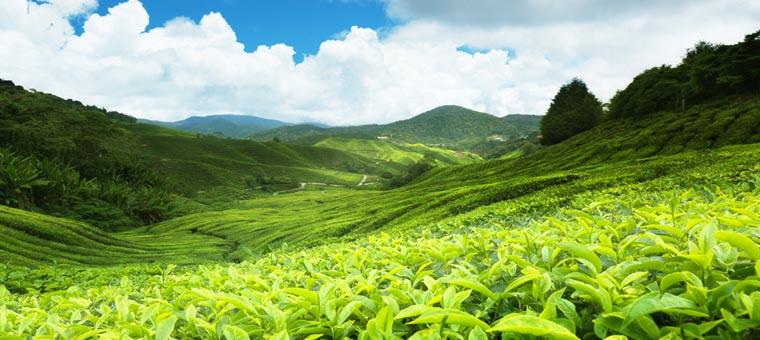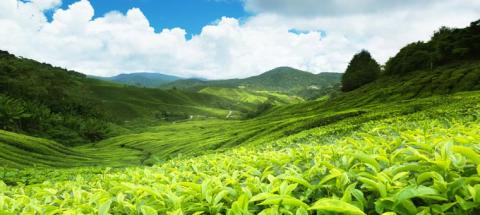Agricultural Ecosystems
The agricultural landscape of the country consists mainly of rice paddies, covering 780,000 ha of cultivated land, and the plantation sector amounting to about 772,000 ha. The plantation crops are tea, rubber, coconut and sugarcane, and, on a smaller scale, coffee, cocoa, cinnamon, pepper, clove and other spices.

Paddy Field
Paddy cultivation receives the highest attention in the agricultural sector. Rice constitutes the staple food of the population and is the backbone of Sri Lanka’s agriculture and its ancient culture. Other crops in this sector include over 100 species used as items of food. Many of these, such as onion, potato and vegetables, remain a small farmer activity, and most fruit species are grown in home gardens. A few crops, such as chilli and cashew, are grown on a semi-commercial scale. A good many field crops also continue to be harvested from chena plots in the dry zone. This method of agriculture, involving the “slash and burn” of forest vegetation, has caused widespread forest destruction in the dry zone where it is practised, and adversely affected biodiversity.
Over the years there has been an expansion of agriculture resulting in an increase in the cultivated land area from around 1.35 million hectares in 1956 to around 2.02 million hectares in 1995. Home gardens also make a substantial contribution to agricultural production, and it is estimated that there are now a total of around 1.33 million home gardens in Sri Lanka, accounting for about 367,800 ha of cultivated land. Home gardens constitute a traditional system of perennial cropping for a wide range of valuable crops and are considered important sites for in-situ conservation of crop germplasm. Today, however, only those categorized as Forest Gardens or the typical Kandyan home gardens in the districts of Kandy, Matale, Kegalle and Kurunegala are worthy of being recognized as such, and even these are now known to be dwindling due to land fragmentation caused by the rapidly changing socio-economic conditions in these areas.
Sri Lanka’s farming systems which have evolved over thousands of years include a rich array of cultivated plants including grains, vegetables, fruits and spices, and livestock. Adding to this, numerous new local cultivars have been developed in the plantation sector during this century.
In terms of crop biodiversity, the long history of rice cultivation and the wide range of eco-edaphic conditions present in the country have resulted in Sri Lanka having a wide varietal diversity of Oryza sativa. Indigenous rice varieties show adaptability to various adverse climatic conditions. For instance, traditional upland varieties are well known for their drought tolerance; varieties grown in the coastal areas and floodplains of rivers possess tolerance of submergence and flash floods; the few rice varieties cultivated at higher elevations (over 1000 m) can grow at low temperatures; and several varieties show broad-based resistance to serious pests and to high salinity and other adverse soil conditions.
Sri Lanka also has considerable biodiversity in terms of other cereals such as millet, sorghum and maize. Finger millet is the staple food of the dry zone chena cultivator, and is grown in almost all the chena holdings. Maize is also widely cultivated in the dry zone for human consumption and animal feed. In contrast, the cultivation of sorghum is very limited in extent and is restricted to the drier parts of the country. Unlike rice, most other cereals have undergone little selection by farmers.
Grain legumes, such as cow pea, green gram, black gram, winged bean, and soya bean constitute an important source of protein for most Sri Lankans, particularly in rural areas, and are increasingly used for crop diversification. Winged bean, in particular, shows much genetic variability as is evident in the seed colour, pod size and flower colour.
Sri Lanka has been world-renowned for its spices for centuries. There are at least eight indigenous species of Cinnamomum, of which the wild species are restricted to the natural forests of the wet zone. Cultivation of cinnamon for commercial purposes has also been widespread in the south-western coastal areas since the mid fifteenth century. Another important local spice crop is Elettaria cardamomum. Cardamom cultivation and the cultural practices associated with it in the Knuckles forest, where conditions are ideal for the growth of this species, has had very adverse effects on forest biodiversity and the regeneration of canopy species. The spice plant Piper nigrum (pepper) and the betel leaf plant Piper betle are both widely cultivated in the lowland wet and intermediate zones of Sri Lanka. The latter is sometimes grown in forest deniya lands, causing the destruction of wetlands in the forest. Syzygium aromaticum (clove) is cultivated in home gardens of the Kandyan and Matale districts, and Areca catechu (arecanut or betelnut) is a common home garden species in the wet zone. A wild relative of arecanut, A. concinna, is considered endangered in the wild. Among other spice crops found in Sri Lanka are three species of nutmeg (Myristica), two species of chilli, (Capsicum annum and C. frutescens) and one species each of ginger (Zingiber officinale) and turmeric (Curcuma longa).
Among the horticultural crops grown in Sri Lanka, there are several cultivars of banana (Musa spp.) cultivated in the different agro-ecological regions of the country. Interestingly, M. acuminate and M. balbisiana, the parent species of the cultivated banana are both present in Sri Lanka.
There is also considerable genetic variation among a wide range of fruit crops, such as citrus, mango, avacado and jak, that are grown mainly in home gardens. Other fruit crops such as durian, pomegranate, rambutan, guava and papaw have also been in cultivation for a long time and exhibit a wide range of genetic diversity. Fruit crops such as wood apple and velvet tamarind are a source of income for the dry zone farmers, and are harvested from forests for sale. Of concern is the fact that harvesting of the latter species from forests is destructive as it involves chopping down of large fruit bearing branches to facilitate collection. Sri Lanka has a large number of vegetables, including both temperate and tropical species, cultivated throughout the country. Among these, cucurbits, tomato and eggplant exhibit high genetic diversity. There is also a fair number of root and tuber crops, of which cassava, dioscorea and innala show considerable genetic variation. Sweet potato, although introduced to this country, is naturalized and has high genetic variability.
With regard to the ex situ conservation of agricultural germplasm, this activity was placed on a sound scientific footing by the setting up of the Plant Genetic Resources Centre for the cryo preservation of plant germplasm.
Other institutions carrying out ex situ conservation of food crops, but only as field gene banks, are the Horticultural Crops Research and Development Institute (for fruit and vegetable species, root and tuber crops), the Rice Research and Development Institute (for rice genes), and the Field Crop Research and Development Institute (coarse grains, grain legumes and condiments). These institutes are under the Department of Agriculture. The Department of Export Agriculture maintains germ plasm of coffee, cocoa, cardamom and clove. There is an inadequacy of field gene banks for traditional species of fruits (e.g. madan, atamba, divul, himbutu), grain legumes, and medicinal plants.

SriLanka Tea Plantation
The economy of Sri Lanka has been long dominated by plantation crops, mainly tea, rubber and coconut. Tea germplasm, originally introduced from Assam in 1839, has undergone selection through breeding programmes, and the selected genotypes are being conserved in numerous breeding stations and tea estates in the country. Selection and vegetative propagation have resulted in a series of high-yielding tea clones that are resistant to pests, diseases and drought, and have high rates of fermentation. The rubber plantations in Sri Lanka were initially derived from a highly inbred selection of lines derived from South American seedlings introduced to the country in 1876. Clonal propagation of these lines for selected characters narrowed down this genetic base until, in the early 1980s, 6000 new accessions were introduced from Malaysia from a special collection of wild Hevea germplasm brought in by the International Rubber Research and Development Board from Brazil. With regard to coconut, a number of new varieties and hybrids have been developed in Sri Lanka, and much of this work has been carried out by the Coconut Research Institute. The three crop plantation research institutes and the Sugar Research Institute conserve their respective germplasms as live genebanks at their field stations.
Sri Lanka also has about 170 species of plants of ornamental value, of which about 74 species are endemic. Notably, the natural habitats for several Dendrobium and Vanda species and many foliage plants of commercial value are the wet zone forests of the country. In the livestock industry, the animals commonly reared comprise neat cattle (1,644,000), buffalo (760,900), goats (535,200), sheep (11,400), pigs (84,800) and poultry (9,136,600). The indigenous cattle have a very low genetic potential for milk production, but are resistant to diseases and have the ability to feed on coarse grasses. Several foreign breeds of cattle have been introduced to the country over the last four decades in an effort to boost milk production.
With regard to the local breed of buffalo, there is as yet some uncertainty about its origins. Although it has been stated that it is not indigenous and the wild form is feral, recent evidence from fossil discoveries indicates the existence at some time in the past of an indigenous species of buffalo identified as a swamp type. It is believed that over 95 per cent of the buffaloes in the country are the indigenous “Lanka Buffalo”, while the rest are of foreign origin and belong to the river type. The exotic breeds are the Murah and Surti from India and the Nili-Ravi breed from Pakistan. Little is known about the indigenous varieties of goats, sheep and pigs, and there have been only little efforts to identify and conserve genepools of these breeds.
The local backyard breed of scavenging poultry that are resistant to tropical diseases and were commonly found in many village households prior to 1960s are fast disappearing due to the strong preference for imported germplasm. Efforts have been made by the Department of Animal Production and Health and the Veterinary Research Institute (VRI) to conserve the indigenous animal species of economic value, but they are constrained by insufficiency of funds and infrastructure. The private sector plays an important role in the maintenance of germplasm of livestock, particularly of poultry, and it regularly imports exotic germplasm.

